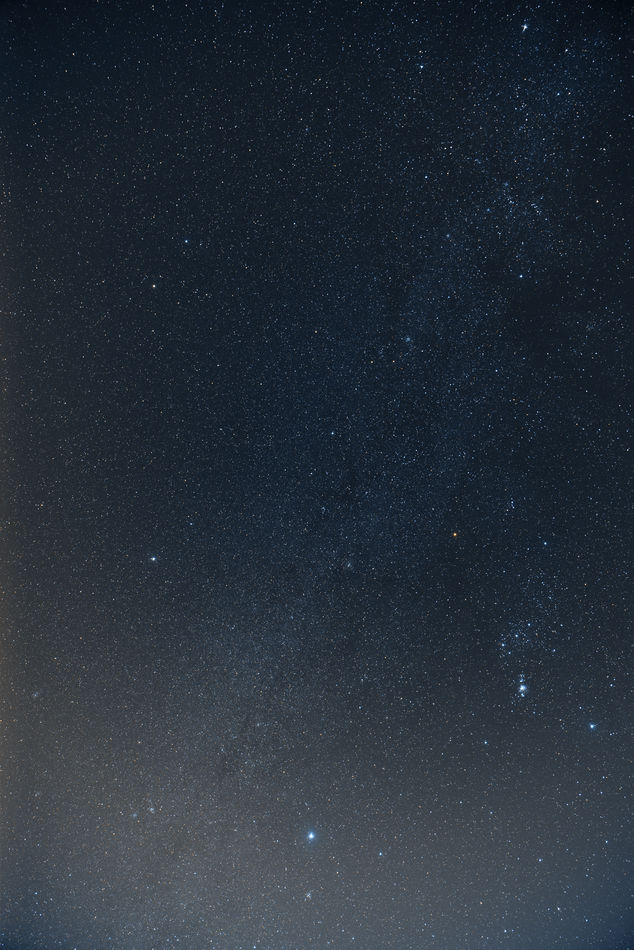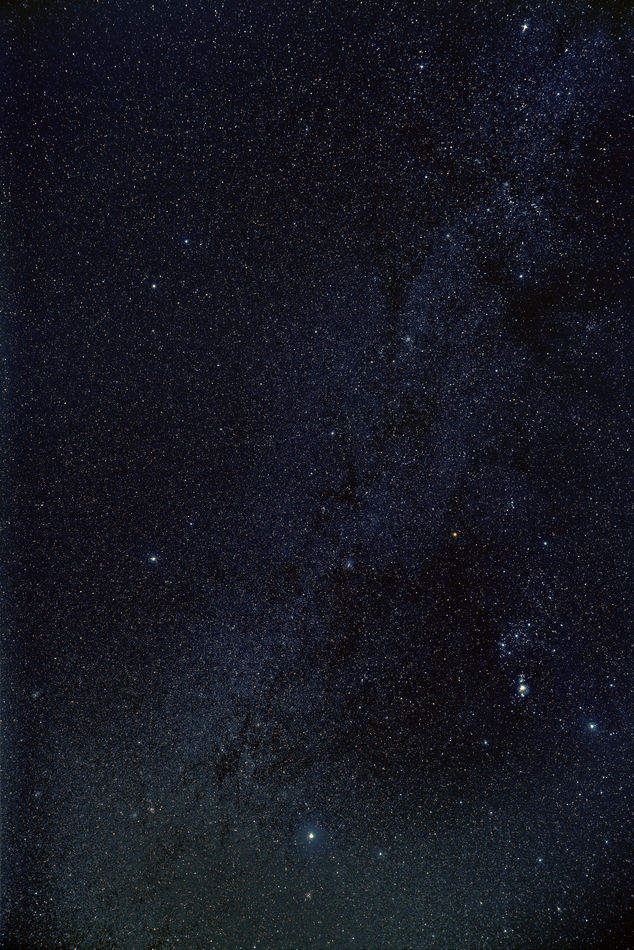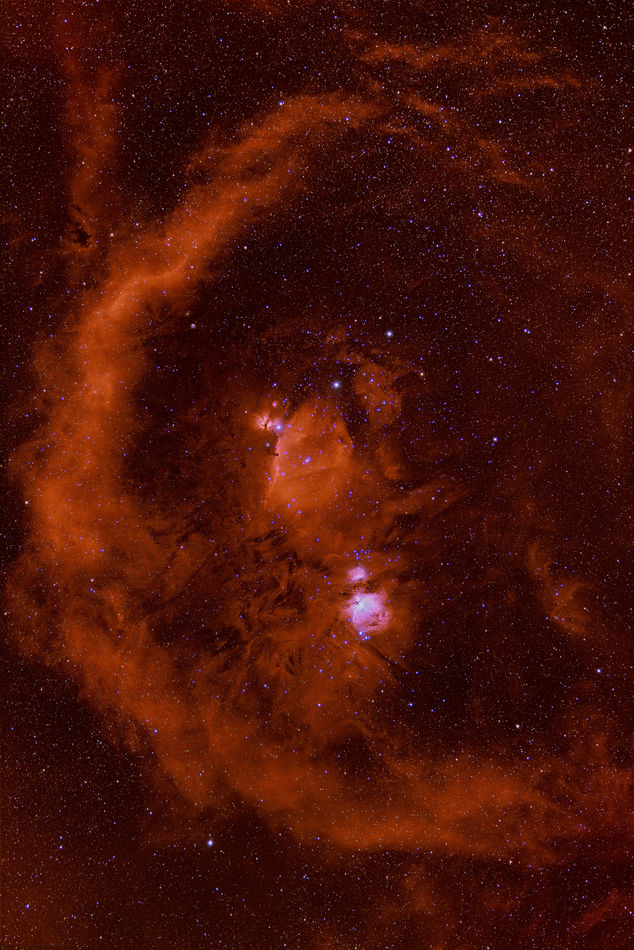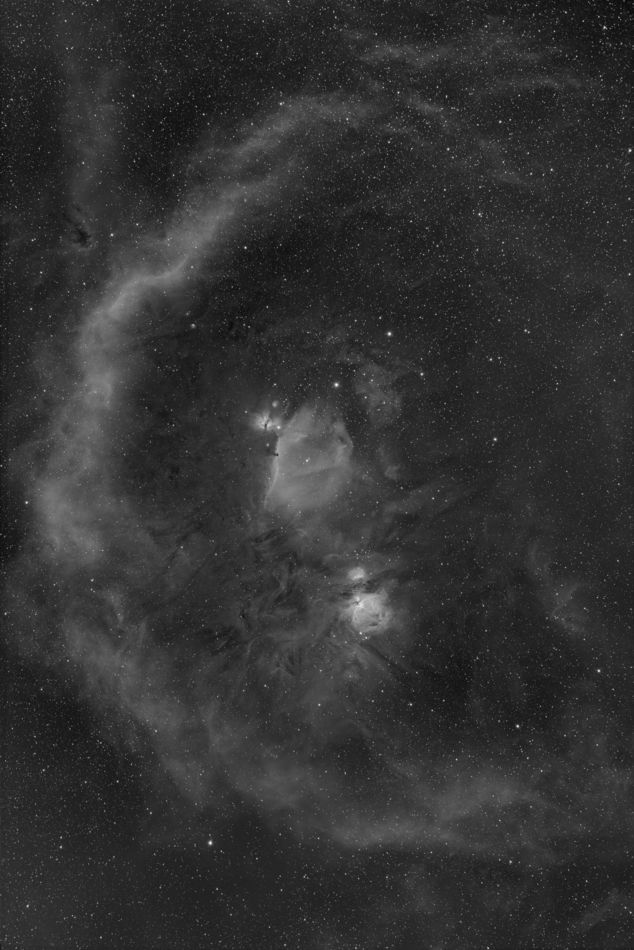Winter Milkyway and Barnard's Loop in Orion
Feb 3, 2022 03:28:01 #
Ballard
Loc: Grass Valley, California
Most people when they look up at the constellation of Orion don't notice the dim band of light that is the winter Milkyway. At this time of year when we look towards Orion, we are looking in the galactic plane and through the outer edge of the galaxy as opposed to the summer when we are looking through the galactic plane but towards the center which has many more stars and is therefore much brighter. The first two images below were taken with a canon DSLR set to ISO 800 with a 24mm lens at F4.0. (These were made by stacking a bunch of 2 minute guided photos and calibrated with Dark, Flat and Bias frames). The second frame was processed to remove some of the light pollution and to enhance the Milkyway. Note: the constellation of Orion is to the right of the Milkyway and towards the bottom of the image. If you download the photo you can see the Orion Nebula in the middle of Orion's sword and the Flame nebula at the end of his belt. Also note the bright red star called Betelgeuse in Orion's shoulder.
The next image is an HDR composite taken at 120mm focal length with a cooled camera that can see the hydrogen alpha spectrum (HA) which the standard DSLR is blind to. The image shows the center of Orion and all the nebula that it contains. The large arc is known as Barnard's loop named after Edward Emersion Barnard who first imaged and described it. The Arc is 1434 light years away and approximately 300 light years across. The Arc is thought to have originated from a supernova explosion that occurred around 2 million years ago. Note: the Orion Nebula, Flame Nebula and Horsehead Nebula are easily visible in the downloaded image. This image was constructed by using an HA filter for the Red Channel, and a standard Green and Blue filter for their respective channels. Most of the detail comes from the HA image which has been included in the image set below. All questions, comments and suggestions are welcome.
The next image is an HDR composite taken at 120mm focal length with a cooled camera that can see the hydrogen alpha spectrum (HA) which the standard DSLR is blind to. The image shows the center of Orion and all the nebula that it contains. The large arc is known as Barnard's loop named after Edward Emersion Barnard who first imaged and described it. The Arc is 1434 light years away and approximately 300 light years across. The Arc is thought to have originated from a supernova explosion that occurred around 2 million years ago. Note: the Orion Nebula, Flame Nebula and Horsehead Nebula are easily visible in the downloaded image. This image was constructed by using an HA filter for the Red Channel, and a standard Green and Blue filter for their respective channels. Most of the detail comes from the HA image which has been included in the image set below. All questions, comments and suggestions are welcome.
Winter Milky way (Note: the glow at the bottom of the image from Sacramento 50 miles to the south).

(Download)
Same image of the Winter Milkyway but processed to decrease the light pollution and enhance the Milkyway.

(Download)
Image contains Barnard's Loop, the Orion Nebula, Horsehead and the Flame nebula.

(Download)
Hydrogen Alpha image that was used for the Red Channel and contains most of the Nebula detail.

(Download)
Feb 3, 2022 04:04:58 #
Ballard wrote:
Most people when they look up at the constellation... (show quote)
Wow, that is all rather interesting. I have not done much astronomy related photography myself. Wow there are more exciting Orion related objects than I had realized. Having lived 99.9% of my life in Los Angeles county I have rarely seen the Milky Way Galaxy but on the rare occasions where I have traveled from L.A. I have photographed 3 comets from Joshua Tree N.P. long ago on film with varying success. I have since May 2020 moved to Grover Beach, CA. But here there is usually too much cloud cover at night to view the night sky and there would still be a good amount of light pollution. For you, have you ever tried the Carrizo Plain in CA? East of Santa Maria, CA and West of Bakersfield. It is really dark on moonless nights with mountains all around but to the North with a few small towns. You have some amazing images you posted.

Feb 3, 2022 05:05:54 #
Feb 3, 2022 12:56:49 #
Ballard
Loc: Grass Valley, California
lamiaceae wrote:
Wow, that is all rather interesting. I have not d... (show quote)
Hi lamiaceae
Thanks for checking out the image of Barand's Loop, for the comment and Thumbs up. I never have tried the Carrizo Plain but have heard that it has dark skies. I plan to visit Big Basin in Neveda this year on a multipark RV trip and will bring a small guider and camera along. When using Narrow Band filters light pollution is greatly attenuated allowing even folks in light polluted areas to image some deep sky objects, they won't help with clouds, however.
Feb 3, 2022 12:57:44 #
Ballard
Loc: Grass Valley, California
J-SPEIGHT wrote:
Outstanding images
Hi J-SPEIGHT
Thanks for checking out the photo of Barnard's loop and for the comment.
Feb 3, 2022 15:26:22 #
Ballard wrote:
Most people when they look up at the constellation... (show quote)
Stunning shots of heaven





Feb 3, 2022 17:49:25 #
Ballard
Loc: Grass Valley, California
joecichjr wrote:
Stunning shots of heaven 









Hi joecichjr
Thanks for the comment and for viewing the image of Barnard's loop.
Feb 4, 2022 06:16:32 #
Feb 4, 2022 09:02:01 #
Wow, you really did a good job on bringing out the Barnards Loop, it really gives a different perspective.
Feb 4, 2022 09:03:34 #
Feb 4, 2022 09:51:34 #
Feb 4, 2022 11:07:35 #
Ballard
Loc: Grass Valley, California
ecobin wrote:
Wow!
Hi ecobin
Thanks for checking out the image of Barnard's Loop and for the comment.
Feb 4, 2022 11:11:22 #
Ballard
Loc: Grass Valley, California
alberio wrote:
Wow, you really did a good job on bringing out the Barnards Loop, it really gives a different perspective.
Hi alberio
Thanks for checking out the photo of Barnard's loop and for the comment. The Hydrogen alpha really brings it out as well as all the Nebulosity in the area.
Feb 4, 2022 11:12:30 #
Ballard
Loc: Grass Valley, California
phlash46 wrote:
Wow!
Hi phlash46
Thanks for viewing the images of Winter Milkyway and Barnard's Loop and for the comment.
Feb 4, 2022 11:13:58 #
Ballard
Loc: Grass Valley, California
tcthome wrote:





Hi txthome
Thanks for viewing the images of the Winter Milkyway, Barnard's Loop and for the Thumbs up.
If you want to reply, then register here. Registration is free and your account is created instantly, so you can post right away.





